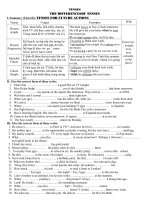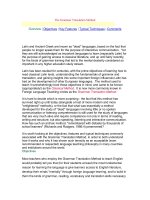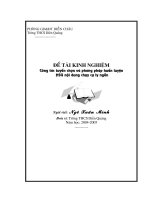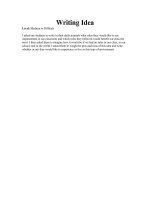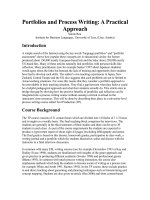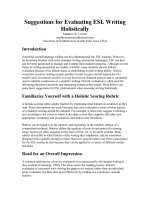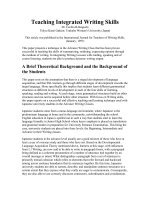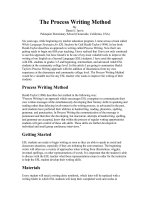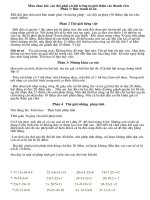The Process Writing Metho1.doc
Bạn đang xem bản rút gọn của tài liệu. Xem và tải ngay bản đầy đủ của tài liệu tại đây (81.58 KB, 4 trang )
The Process Writing Method
By
Daniel J. Jarvis
Palmquist Elementary School (Oceanside, California, USA)
Six years ago, while beginning my teacher education program, I came across a book called
Whole Language Strategies for ESL Students by Gail Heald-Taylor (1994). In her book
Heald-Taylor describes an approach to writing called Process Writing. Now that I am
getting ready to begin my fifth year teaching, I have realized that I have not only continued
to use this approach, but have found it to be one of my most valuable tools to improve the
writing of my English as a Second Language (ESL) students. I have used this approach
with ESL students in grades 3-5 and beginning, intermediate, and advanced Adult ESL
students at the community college level. In this article I am going to summarize Heald-
Taylor's Process Writing approach with the addition of illustrations from my own
experience at the elementary and community college level. The Process Writing Method
would be a valuable tool for any ESL teacher who wants to improve the writing of their
students.
Process Writing Method
Heald-Taylor (1986) describes her method in the following way:
"Process Writing is an approach which encourages ESL youngsters to communicate their
own written messages while simultaneously developing their literacy skills in speaking and
reading rather than delaying involvement in the writing process, as advocated in the past,
until students have perfected their abilities in handwriting, reading, phonetics, spelling,
grammar, and punctuation. In Process Writing the communication of the message is
paramount and therefore the developing, but inaccurate, attempts at handwriting, spelling,
and grammar are accepted, know that within the process of regular writing opportunities
students will gain control of these sub-skills. These skills are further developed in
individual and small group conference interviews."
Getting Started
ESL students are ready to begin writing as soon as they are able to speak in social and
classroom situations, especially if they are initiating the conversations. The beginning
writer will often use a variety of approaches when writing from illustrations, wiggles,
invented spellings, or other representations of words. It is important that the student is able
to discuss with the ESL teacher what those representations mean in order for the instructor
to help the ESL student develop their writing skills.
Materials
Every student will need a writing dairy notebook, which later will be replaced with a
writing folder in which ESL students will keep their completed work and works in
progress. Students will also need a daily journal with about 30 pages of lined or unlined
paper. Unlined paper is especially useful for the beginning writer, who may communicate
their messages using illustrations or wiggles. The daily journal is intended for students to
make journal entries on a daily basis. Students are asked to write on one side of the page.
The other side is for comments made by the teacher and for translation. Having students
write in a daily journal is extremely useful in that you have a daily record of the student's
growth. These are very useful to use over the course of a school year. Teachers can
pinpoint specific areas that students need assistance in. I have also found these very useful
during parent-teacher conferences or problem solving team meeting. This allows the
teacher to show what specific areas they have been working on with the student, what
strategies they have used, and the results of the work done. At the end of the school year,
students often value their journals because they can visually see the growth they have
achieved. Journals can also be saved to show growth over multiple years.
Illustrations
Many of the ESL students I have had in my classes have preferred to draw pictures first
because they can include many concepts that they would not be able to express verbally.
Drawings and illustrations are a very important part of beginning writing. However, not all
students will draw first. Many will prefer to write before they draw a picture. Illustrations
are a way for ESL students to understand new concepts or vocabulary in a context that
makes the new concepts or vocabulary meaningful and more readily internalized by the
learner. Illustrations also enable ESL students to link new concepts and vocabulary to prior
knowledge by visually showing the connection between different concepts. I have had
many students who have had a love and a talent for art, which helped develop their love of
writing because they could see the connection between how writing can influence art and
how art can influence their writing.
The First Lesson
The very first lesson will be a modeling of how to develop and write a story. Modeling the
process helps to ensure that the students grasp the assignment. The class will begin by
developing a class story with the students assisting in the development and the writing of
the story. The story can be written on the chalkboard, chart paper, or on overhead
transparencies. Give the students the option of what to write about and ask them what you
should write for the very first sentence. Have the students try to say the sentence out loud
and have the author try to write the sentence on the chalkboard, chart paper, or overhead
transparencies. The student may only know one of the letters of a word or may not know
the work at all. If the student does not know the word or a large portion of a word, have the
student write a line or wiggle to represent the word or partial word. Ask the rest of the class
to assist in completing the words and sentence. In these beginning stories, grammar and
syntax may not always be perfect. Accepting the language a student uses at the time is very
important. Over time, as the student has more opportunity to develop language, the student
will improve in their language ability. Accepting the varying ability levels of is very
important. All students should feel good about wanting to participate and feel successful
about the progress they are making in writing. It is also very important that you teach your
students to be accepting of the different ability levels in the class, especially for the Adult
ESL student. In my experience, adults are much more affected by the criticism of their
classmate than young students. Adult students who do not feel good about their writing will
not write or want to share their writing. All students need to fell good about the progress
they have made.
On Their Own
Everyday ESL students need to be encouraged to work on writing their own stories and
making entries in their diaries. Students need to know that they must practice writing every
day. They need to understand that it is okay to make mistakes in their stories and journal
and not to get stuck on worrying whether or not their writing is perfect. In my class, I
explain to my students that writing like anything else they want to get better at requires
practice. Having a pencil on paper is the only way that students will improve their writing.
This is also an area where teachers have a problem. Many teachers see more writing as
more work they have to grade and correct. If students write stories and dairy entries daily,
at the end of the week this may seem like a lot of grading for the teacher to do. Teachers
need to be okay with not having to grade and correct every piece of writing a student
creates. Students and parents also need to understand that not every piece of writing will be
corrected and graded. Here is an example of how to relate this to other aspects of life. If
your student is involved in a sport, they will attend practice all week long, however, the
wins and losses that occur during practice are not recorded. Practice is a time to make
mistakes and get better. Game days are the only event that really "counts" on the win/loss
column. It is the same way with writing. Students need the opportunity to practice, to make
mistakes and get better. Then they take what they have learned and apply it on "Game Day"
or in education "Test Day." Using this approach a teacher will not become overwhelmed by
grading a never-ending stack of paper.
Translation
When students complete their stories many of them will have lines, wiggles, invented
spelling, and other representations for words. Take this opportunity to have the student
"read" their stories to you. While the student in reading their story, use the blank side of the
paper to write the translation of their story in the proper form. Go over the translation of the
story with the student pointing out what they did correctly. Knowing what they did
correctly allows students to feel good about what they are doing right and shows them what
they need to work on without focusing on the negative.
"What Should I Write About?"
In the beginning, many students will have a difficult time deciding on a topic to write
about. At first, the teacher may need to provide students with topics based upon learning
experiences they have had in the classroom, experiences at home, or experiences they have
had in the world. It is important to develop topics with which the students have had some
experience. This allows the student to draw upon prior knowledge to connect with the
writing topic. This will expand the base of vocabulary that a student has to draw from in
the development of their story. Students need to "see" the connection between writing and
other subjects. By developing an understanding of the connection between subjects,
students will not only progress in the development of their writing but also in the other
subject areas.
Student-Teacher Writing Conferences
Teachers need to set up individual conference interview with their ESL students to support
their writing development. Heald-Taylor states,
"In conference interviews students are invited to further develop their stories, to add more
information, to include descriptive language, to order information, and to develop skills in
phonetics, spelling, grammar, and punctuation."
Heald-Taylor describes two types of conferences, the content conference and the skill
conference. In the content conference, the teacher asks the student for more information
about their story. Some students will respond verbally and some will add additional
information to the story. It is important not to push students in to the drafting and revising
process. They will do this on their own when they are ready. It is also important for the
teacher not to revise or edit their work for them. When a teacher does this the writing is no
longer the students writing. It has become the teacher's creation. During the skill
conference, the student and teacher will focus on writing skills such as phonetics, spelling,
grammar, and punctuation. It is important that the teacher only focuses on one skill at a
time until that skill is learned. Allow the students to guide the direction of skill focus by
allowing them to incorporate knowledge they have already learned. Students are more
likely to internalize new skills if they can make connections to prior knowledge.
Why Process Writing Works
As any ESL teacher will tell you, ESL students of the same age and grade level will have
varying abilities in writing. Process Writing will assist ESL students, whatever their ability
level, improve their writing. Once an ESL student understands the process and trust that the
teacher will accept and approve of their invented symbols and spelling, the ability to write
improves dramatically. The key to learning to write is feeling confident in your abilities.
Many students do not enjoy writing because they feel that if they cannot do it correctly the
first time then they will never get it. Learning to write like learning to do many things
requires practice and time. All students are capable to becoming excellent writers given
enough practice and time. The Process Writing method values the talents and growth of
individual writers and makes them want to continue writing because they feel good about
their abilities. The Process Writing method is an approach that has help me developed
many youngsters and adults into wonderful writers.
